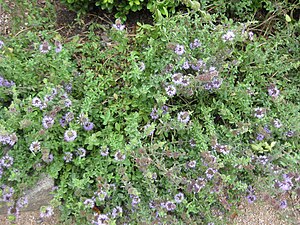Note: This is a project under development. The articles on this wiki are just being initiated and broadly incomplete. You can Help creating new pages.
Difference between revisions of "Hedeoma pulegioides - American pennyroyal"
Chaithrika (talk | contribs) (+Common names) |
Chaithrika (talk | contribs) m (Chaithrika moved page Pudding grass to Mentha pulegium: renaming as per convention) |
(No difference)
| |
Revision as of 12:58, 8 March 2017
Pudding grass, commonly (European) pennyroyal, also called squaw mint, mosquito plant and Mentha pulegium, is a species of flowering plant in the family Lamiaceae native to Europe, North Africa, and the Middle East. Crushed pennyroyal leaves exhibit a very strong fragrance similar to spearmint. Pennyroyal is a traditional culinary herb, folk remedy, and abortifacient. The essential oil of pennyroyal is used in aromatherapy, and is also high in pulegone, a highly toxic volatile organic compound affecting liver and uterine function.
Uses
- Pennyroyal was commonly used as a cooking herb by the Greeks and Romans. The ancient Greeks often flavored their wine with pennyroyal.
- Pennyroyal is used to make herbal teas, which, although not proven to be dangerous to healthy adults in small doses, is not recommended, due to its known toxicity to the liver.
- It has been traditionally employed as an emmenagogue (menstrual flow stimulant) or as an abortifacient.
- Pennyroyal is also used to settle an upset stomach and to relieve flatulence.
- The fresh or dried leaves of pennyroyal have also been used when treating colds, influenza, abdominal cramps, and to induce sweating, as well as in the treatment of diseases such as smallpox and tuberculosis, and in promoting latent menstruation.
Common name
- English - pudding grass
